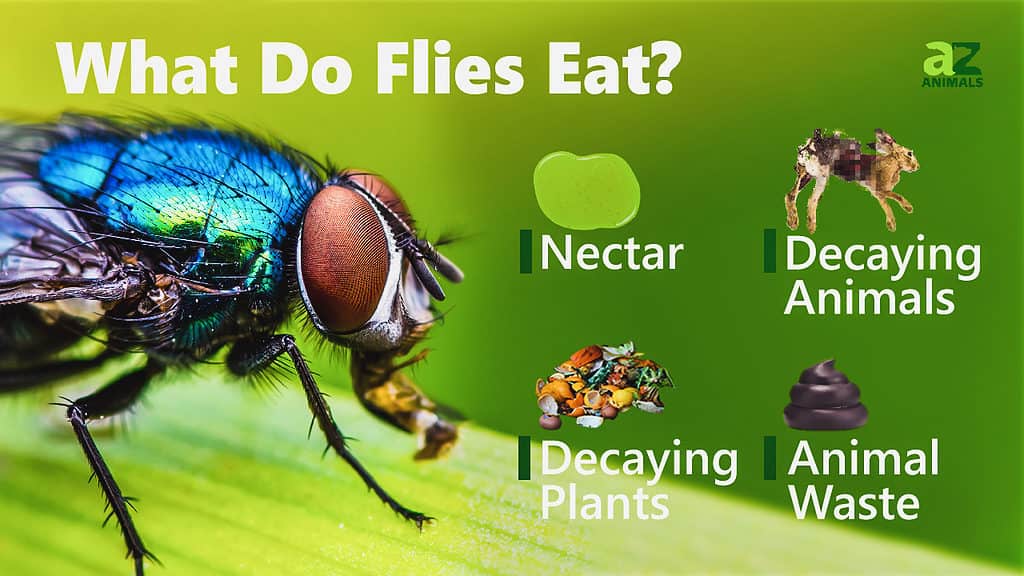
The world of insects is incredibly diverse, and flies are a prime example of this. Often seen as pests, flies play a surprisingly complex role in our ecosystems. While some species might buzz around your picnic basket seeking sugary treats, others engage in fascinating behaviors like hunting other insects or even pollinating flowers. This article delves into the multifaceted world of flies, exploring their diverse diets, predatory and prey roles, and contributions to pollination.
This exploration will begin by examining the general feeding habits of flies, highlighting their omnivorous nature. We’ll then delve deeper into specific species that exhibit predatory behavior, showcasing their hunting techniques and prey preferences. Conversely, we’ll also shed light on the vulnerability of fly larvae, which often serve as a vital food source for various animals. Finally, we’ll discuss the often-overlooked role of flies in pollination, demonstrating their importance to plant life and ecosystems.
Fly Diet and Feeding Habits
Flies are renowned for their opportunistic feeding habits, consuming a wide range of substances depending on the species and stage of life. Adult flies primarily feed on nectar, fruit, decaying organic matter, and even animal excrement. This diverse diet allows them to thrive in various environments, from bustling cities to remote wilderness areas.
Some fly species have specialized feeding mechanisms that allow them to exploit specific food sources. For instance, house flies possess sponge-like mouthparts designed for lapping up liquids, while blowflies have sharp, piercing mouthparts used to extract fluids from decaying flesh. This adaptability contributes to their success as scavengers and decomposers, playing a crucial role in nutrient cycling within ecosystems.
Omnivorous Nature of Flies

The term “omnivore” aptly describes the dietary habits of flies, encompassing both plant and animal matter. While many species primarily feed on nectar and fruit, others exhibit more carnivorous tendencies, preying on other insects or even small vertebrates. This omnivorous nature allows flies to exploit a wide range of food sources, ensuring their survival in diverse environments.
The ability to switch between different food types provides flies with a significant advantage in fluctuating ecological conditions. When preferred food sources become scarce, they can readily adapt their diet to available resources, enhancing their resilience and adaptability. This dietary flexibility contributes to the widespread distribution and success of flies across various habitats.
Predatory Flies
While often perceived as mere pests, certain fly species are formidable predators, actively hunting other insects for sustenance. These predatory flies possess specialized adaptations that enable them to capture and subdue their prey. Robber flies, for example, are renowned for their lightning-fast reflexes and powerful jaws, capable of paralyzing even larger insects like bees and wasps.
Another group of predatory flies, the tachinid flies, lay their eggs on or within other insect hosts. The developing larvae then feed on the host’s tissues, eventually killing it. This parasitic strategy allows tachinid flies to effectively control populations of pest insects, playing a beneficial role in agricultural ecosystems.
Prey Species: Fly Larvae

Despite their predatory prowess as adults, fly larvae, commonly known as maggots, are often preyed upon by various animals. Birds, reptiles, amphibians, and even other insects consume fly larvae as a readily available food source. This vulnerability highlights the intricate web of life within ecosystems, where organisms occupy different trophic levels, feeding on each other in a continuous cycle.
The high protein content of fly larvae makes them a nutritious food source for many predators. Their abundance and widespread distribution further contribute to their role as a vital link in the food chain.
Pollination by Flies
While often overlooked, flies play a significant role in pollination, contributing to the reproduction of numerous plant species. Certain fly species are attracted to flowers with strong scents and dull colors, which differ from the typical preferences of bees and butterflies. This specialized pollination strategy allows plants to access a wider range of pollinators, ensuring their reproductive success.
Flies transfer pollen as they feed on nectar and other floral rewards. While not as efficient as bees in terms of pollen transfer, flies still contribute significantly to the pollination process, particularly for plants that rely on less conventional pollinators.
Conclusion
The world of flies is far more complex than their often-negative reputation suggests. These fascinating insects exhibit a diverse range of behaviors, from scavenging and decomposing to hunting and pollinating. Their omnivorous nature allows them to thrive in various environments, while their predatory and prey roles highlight the intricate web of life within ecosystems. Understanding the multifaceted world of flies is crucial for appreciating their ecological significance and promoting a more balanced perspective on these often-misunderstood creatures.
